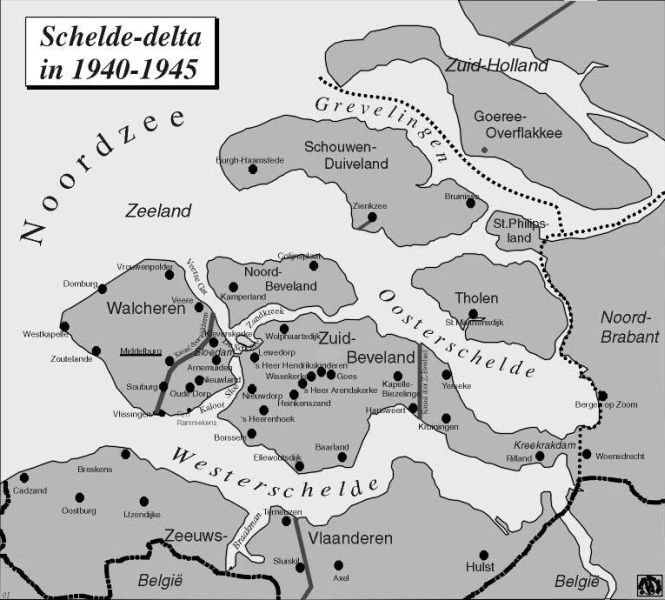Preface
For the Royal Dutch Navy, the most direct and visible contribution to the liberation of The Netherlands was the participation in mine sweeping actions on the Scheldt in the second half of 1944. After the large allied invasion in Normandy on 6 June 1944 and the finale of 2,5 months of bitter fighting at Falaise in August 1944, American, British, Canadian and Polish troops advanced further into North West Europe. On 2 September 1944 the allies advanced into Belgium where the fighting was remarkably easier. Already one day later, Brussels and Tournai were liberated followed by Mechelen, Louvain and Antwerp a day later. The last city especially was of tantamount importance to the allies. Antwerp was the third largest harbour of West Europe and was captured almost entirely intact. The Belgian resistance played an important role in this. The German Ardennes Offensive from 16 December 1944 onwards was primarily intended to reconquer Antwerp and by doing so to split the allied armies and cut off their main source of supply.
In order to be able to use Antwerp's large port facilities the 70 kms long waterway from the Scheldt estuary to the Flemish harbour had to be cleared. The most western part of this stretch, between Zeeuws Vlaanderen, South Beveland and Walcheren, remained under German control. In order to capture Walcheren an amphibious landing on a large scale was necessary, operation Infatuate. After British heavy bombers destroyed parts of the dikes, a large part of the island and with it the extensive German defensive positions was flooded. On 1 November, the first allied assault waves came ashore. In Flushing, British No.4 Army Commando managed to drive away the Germans after vicious fighting. Also in Westkapelle there was heavy fighting but the allies were supported by the heavy batteries of the battleship HMS Warspite and the monitors HMS Erebus (I02) and HMS Roberts (F40). On top of that the British and Canadians could count on fighter bombers and rocket firing Typhoons.
In the night of 2 to 3 November 1944, the advancing Canadians captured the Sloedam, the connecting dam between South Beveland and Walcheren. The German forces by now were surrounded on three sides and they capitulated on 8 November. Some 2,000 Germans became prisoners of war. In the meantime the rest of Zeeuws Vlaanderen had been liberated so that the entire estuary of the Scheldt was in allied hands. A beginning was made to demine the Westerscheldt. The harbour of Oostende had already been captured by the allies on 10 September 1944 and large efforts were made by the British to press this harbour into service for the supply effort for their troops.
Definitielijst
- Ardennes Offensive
- Battle of the Bulge, “Von Rundstedt offensive“ or “die Wacht am Rhein“. Final large German offensive in the west from December 1944 through January 1945.
- battleship
- Heavily armoured warship with very heavy artillery.
- invasion
- Armed incursion.
- mine
- An object filled with explosives, equipped with detonator which is activated by either remote control or by colliding with the targeted object. Mines are intended to destroy of damage vehicles, aircrafts or vessels, or to injure, kill or otherwise putting staff out of action. It is also possible to deny enemy access of a specific area by laying mines.
- Offensive
- Attack on a smaller or larger scale.
- resistance
- Resistance against the enemy. Often also with armed resources.
- rocket
- A projectile propelled by a rearward facing series of explosions.
Images
 The Dutch Motor Mine Sweeper (MMS) HNLMS Duiveland took part in the clearing operations on the Scheldt Source: Warships ww2.
The Dutch Motor Mine Sweeper (MMS) HNLMS Duiveland took part in the clearing operations on the Scheldt Source: Warships ww2. Bombing of the dikes in order to flood German defences on Walcheren. Source: Wikipedia.
Bombing of the dikes in order to flood German defences on Walcheren. Source: Wikipedia. German prisoners of war in Middelburg. Source: Zeeuwse Ankers.
German prisoners of war in Middelburg. Source: Zeeuwse Ankers.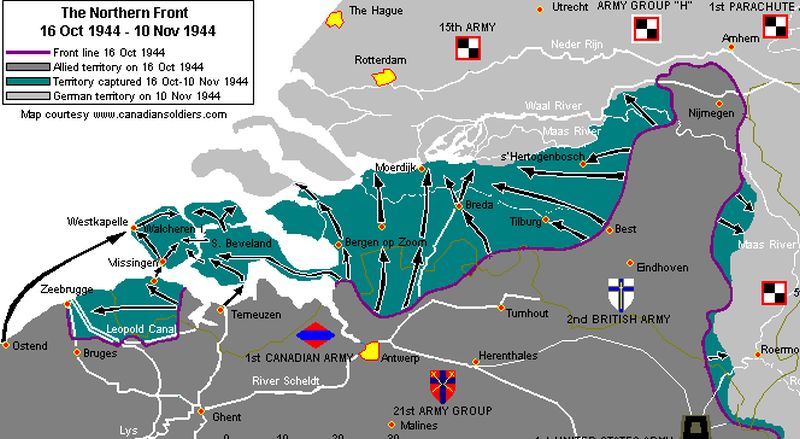 The fight in the South of The Netherlands. Source: Wikipedia.
The fight in the South of The Netherlands. Source: Wikipedia.Mine sweeping activities on the Scheldt
Three days after Oostende was liberated, a Dutch and a British flotilla mine sweepers departed from Harwich. Both flotillas were under command of Captain T. Marsh of the Royal Navy. The British flotilla consisted of the wooden Motor Minesweepers HMS MMS1081, HMS MMS 1042 and HMS MMS 1044 from the so-called 126 foot type, the four Motor Launches HMS ML 216, HMS ML 345, HMS ML 454 and HMS ML 915 and the supply- and mothership HMS Locust, a converted riverine gunboat of the Dragonfly class. The Dutch units were the motor minesweepers of the Ameland class HNLMS Putten, HNLMS Beveland, HNLMS Terschelling (II,) HNLMS Texel (II) and HNLMS Ameland. These ships were bought in Great Britain. The Motor Launches were motorboats with a displacement of only 70 tons that were originally intended for the defence of British ports. As this task was hardly required at this stage of the war, many of the boats were converted into minesweepers. At Thursday 14 September mine sweeping was begun at Oostende in the direction of the Scheldt estuary. The clearing of the Belgian coastal waters was hampered by a strong gale, but the damage it inflicted on the mine sweepers was not severe. On 19 September HMS ML 216 hit a mine and was severely damaged. On 28 September four out of five of the Dutch mine sweepers were relieved by the Ameland class motor minesweeper HNLMS Rozenburg and the motor mine sweepers of the Duiveland class HNLMS Duiveland, HNLMS Schokland and HNLMS Walcheren. The Duiveland class motor minesweepers were also wooden vessels bought in Great Britain, but they were of the so-called 105 foot type. A total of 13 ground mines was swept by Dutch vessels in front of the Belgian coast.
Much larger in size was operation Calendar, the clearing of the 70 kms long waterway between Antwerp and the Scheldt estuary. This operation, commanded by the British Captain H.Hopper, started on 2 November. Ten flottillas took part in this vast mine clearing operation, nine British and one Dutch. The Dutch flottilla consisted of the mine sweepers HNLMS Beveland, HNLMS Terschelling(II) ,HNLMS Texel(II) and HNLMS Vlieland and was commanded by luitenant -ter- zee der eerste klasse A.A.Oepkes. In total more than 100 vessels took part in the mine sweeping operation. The ships performed, while sailing in formation, a total of sixteen swipes between Antwerp and the Scheldt estuary. Rigs were towed against anchored ground mines, acoustic and magnetic mines. The four Dutch minesweepers operated from Terneuzen and cleared the Westerscheldt between Wielingen and Bath. On 11 November HNLMS Beveland was badly damaged by a mine that exploded near the ship. The ship had to return to England for repairs. On 26 November Captain Hopper declared the Scheldt to be free of mines. The allied minesweepers had neutralized a total of 267 mines. The Dutch minesweepers neutralized 21 of them.
Definitielijst
- mine
- An object filled with explosives, equipped with detonator which is activated by either remote control or by colliding with the targeted object. Mines are intended to destroy of damage vehicles, aircrafts or vessels, or to injure, kill or otherwise putting staff out of action. It is also possible to deny enemy access of a specific area by laying mines.
Images
 A British Motor Mine Sweeper (MMS). Source: World of Warships.
A British Motor Mine Sweeper (MMS). Source: World of Warships.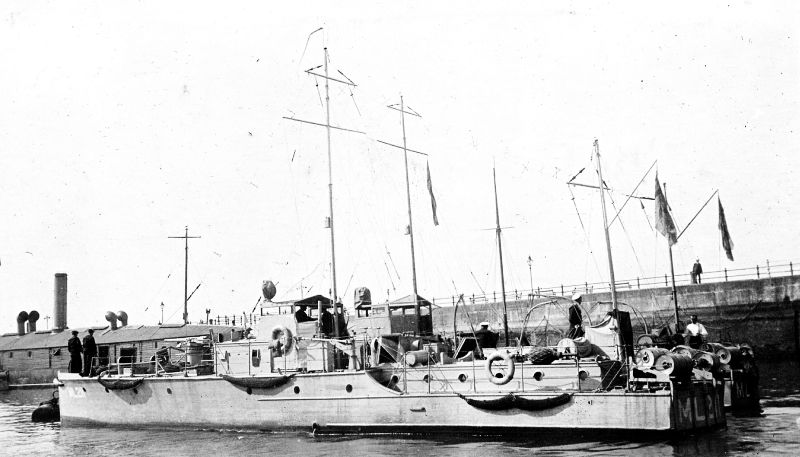 British Motor Launches (ML) in a harbour. Source: Naval History.
British Motor Launches (ML) in a harbour. Source: Naval History.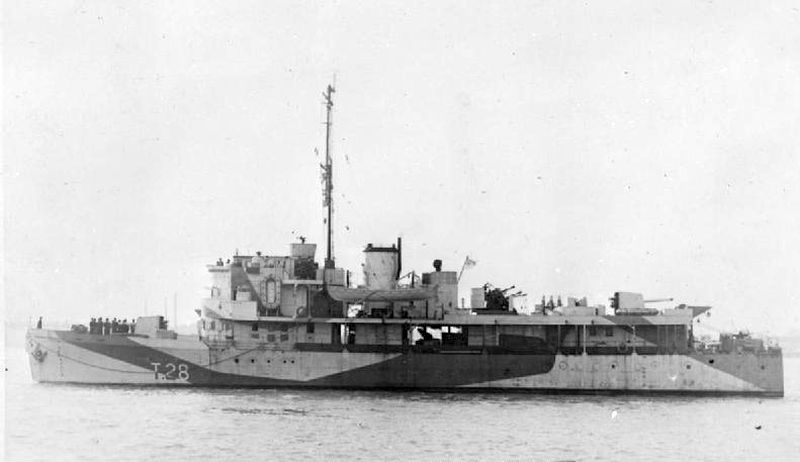 Support ship HMS Locust. Source: Wikipedia.
Support ship HMS Locust. Source: Wikipedia.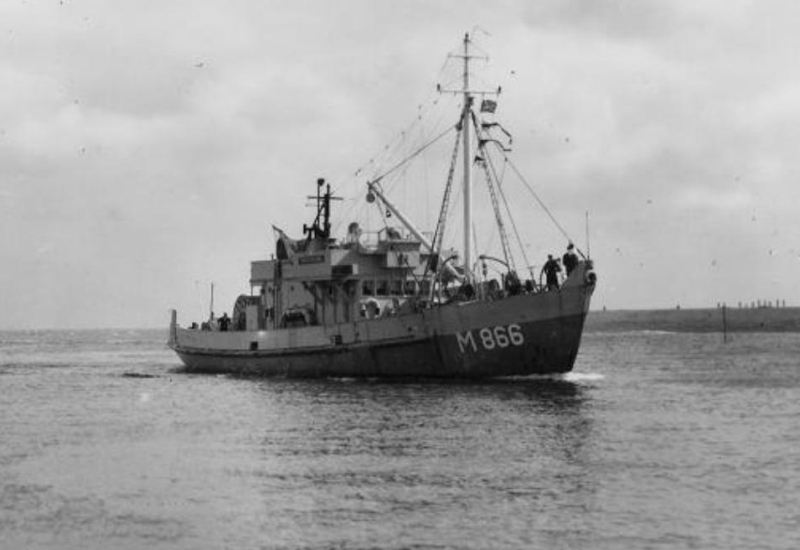 Motor Mine Sweeper HNLMS Terschelling (II) in Den Helder after the war. Source: Maritiem Digitaal.
Motor Mine Sweeper HNLMS Terschelling (II) in Den Helder after the war. Source: Maritiem Digitaal.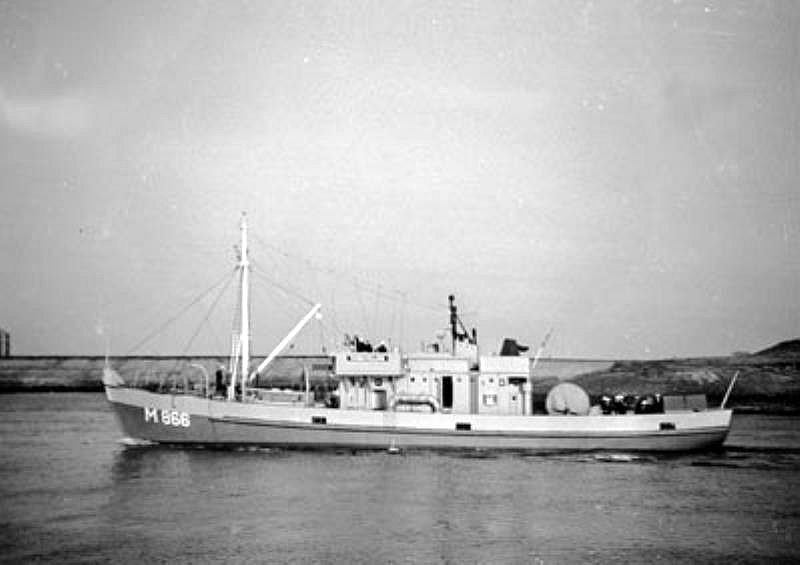 HNLMS Vlieland after the war. Source: Maritiem Digitaal.
HNLMS Vlieland after the war. Source: Maritiem Digitaal.Conclusion
Already on 26 November 1944 three allied coasters arrived from England in Antwerp. Two days later the first allied convoy,T.A.C. 58A, consisting of 18 ships, arrived in Antwerp. On 7 December the last allied minesweepers left the Scheldt area. Although the Scheldt had been declared free of mines, nine vessels would hit mines in December 1944 and a number of them was lost. This was due to the fact that the Germans, after 26 November, laid mines with the aid of airplanes and Schnellboote and because a number of mines had not been swept. In the harbour of Antwerp the Belgian tow boat Orion hit a mine. On 3 December the American freighter Francis Ashbury struck a mine and four days later the British merchant Samsip did the same. On 11 December HMS MMS 257 was lost after hitting a mine and on 15 December the British freighter Fort Maisonneuve had the same fate. The next day the British tanker RFA (Royal Fleet Auxiliary) War Diwan, which was part of convoy T.A.M. 19, struck a mine and broke in two between the buoys NF 15 and NF 17. Two days later the American ship Steel Traveller fell victim to an explosive in the Westerscheldt. The day before Christmas 1944 the British ship Empire Path hit a mine and on Christmas Day the British frigate HMS Dakins (K550) became another victim of a mine in the North Sea at approximately 14 miles north of Oostende. The warship was severely damaged but managed to limp back to Harwich on its own power.
Also in 1945 and in the years after ships incidentally struck mines in the Scheldt area. The sea mines were a huge problem after World War Two for international shipping, not only in Zeeland, but across the whole world. In order to neutralize the mines in Europe and adjacent naval areas an international organisation came into being: The Central Mine Clearance Board. In this organisation the United States, Great Britain, France and the Soviet Union were the major representatives. Under the jurisdiction of this Board four so-called Zone Boards were created. The Netherlands were represented in the East Atlantic Zone Board, which started work on 15 August 1945. Belgium, Denmark, Great Britain, France and Norway were also part of this Zone. Sweden and the Soviet Union sent observers. The Netherlands were tasked by the Board to clear the Dutch waters until 40 miles from shore. For this task the Dutch had at hand, next to their own ships, ten American minesweepers from the BYMS-type (Brooklyn Yard Mine Sweeper) and could deploy units from the former Kriegsmarine.These German units now ressorted under the German Minesweeping Administration in Hamburg. This organisation was directed by the Royal Navy. The mothership Tanga and 23 coastal mine sweepers (Räumboote) were ordered to clear mines in the Dutch zone.
In October 1945 the most important waterways in and around the Netherlands had been cleared and eight motor mine sweepers from the Duiveland-class departed for the colony of the Dutch East Indies. Together with the minelayer HNLMS Jan van Brakel, which functioned as mothership and flotilla leader, the waterways in the Dutch colony were cleared of mines.HNLMS Walcheren hit a Japanese mine during these activities on 19 November 1946 at Balikpapan, East Borneo, and sunk. Three members of her crew were killed.
Definitielijst
- Kriegsmarine
- Germa navy. Part of the Wehrmacht next to Heer and Luftwaffe.
- mine
- An object filled with explosives, equipped with detonator which is activated by either remote control or by colliding with the targeted object. Mines are intended to destroy of damage vehicles, aircrafts or vessels, or to injure, kill or otherwise putting staff out of action. It is also possible to deny enemy access of a specific area by laying mines.
- Soviet Union
- Soviet Russia, alternative name for the USSR.
Images
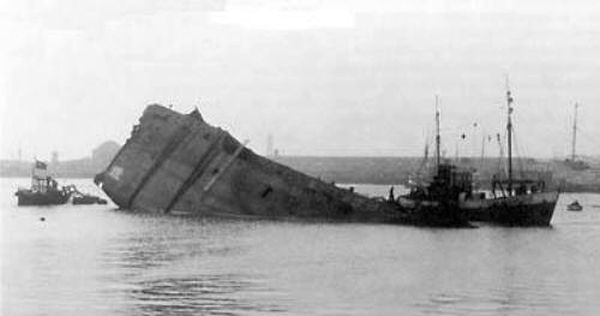 The wreck of the War Divan. Source: Historical RFA.
The wreck of the War Divan. Source: Historical RFA. The first allied coaster in the harbour of Antwerp since 1940. Source: Holandia bestajemnic.
The first allied coaster in the harbour of Antwerp since 1940. Source: Holandia bestajemnic. Dutch mine sweepers of the BYMS class. Source: Maritiem Digitaal.
Dutch mine sweepers of the BYMS class. Source: Maritiem Digitaal.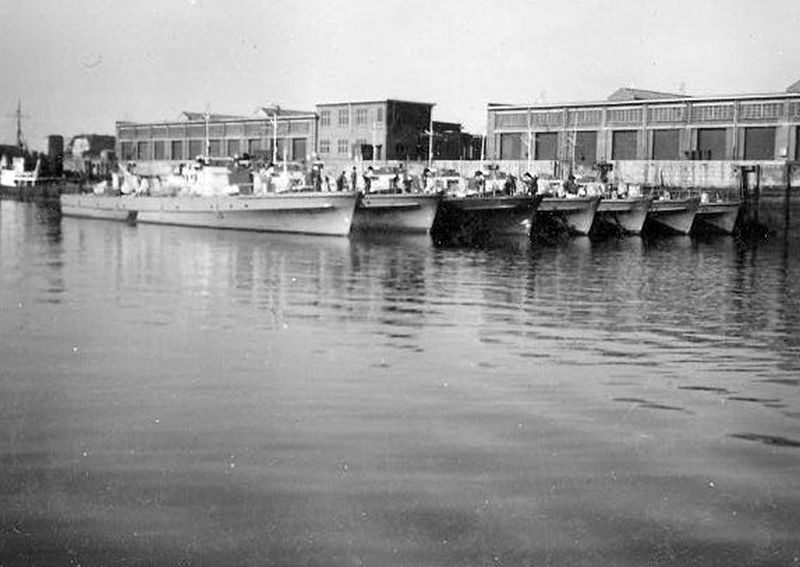 German Räumboote in Flushing. Source: Dutchfleet.
German Räumboote in Flushing. Source: Dutchfleet.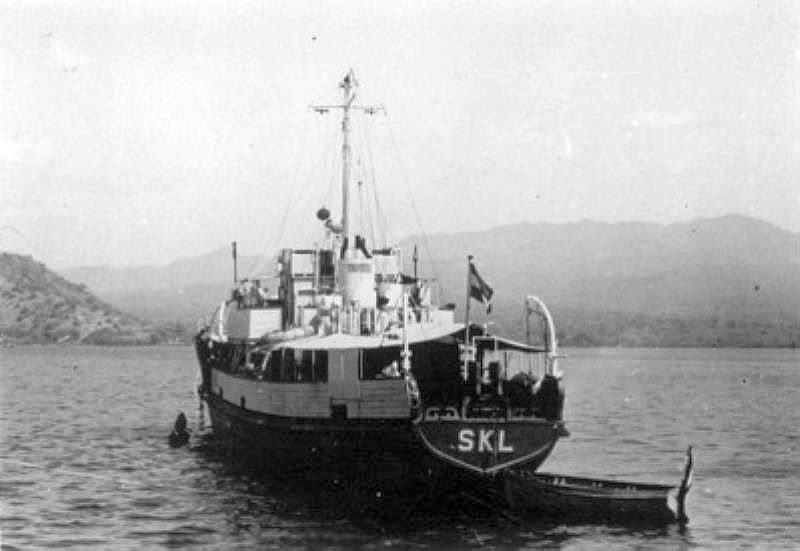 HNLMS Schokland left in October 1945, together with her sister ships, to the Dutch East Indies. Source: Maritiem Digitaal.
HNLMS Schokland left in October 1945, together with her sister ships, to the Dutch East Indies. Source: Maritiem Digitaal.Information
- Article by:
- Peter Kimenai
- Translated by:
- Peter ter Haar
- Published on:
- 20-02-2015
- Last edit on:
- 30-09-2024
- Feedback?
- Send it!
Related books
Sources
- AMSTEL W.H.E. VAN, De schepen van de Koninklijke Marine vanaf 1945, De Alk bv, Alkmaar, 1991.
- BEZEMER, K.W.L., Verdreven doch niet verslagen, Uitgeversmaatschappij W. de Haan N.V., Hilversum, 1967.
- BOSSCHER, PH., M., De Koninklijke Marine in de Tweede Wereldoorlog deel 3, Uitgeverij T. Wever B.V., Franeker, 1990.
- MARK, C., Schepen van de Koninklijke Marine in W.O. II, De Alk bv, Alkmaar, 1997.
- MüNCHING, L.L. VON, Schepen van de Koninklijke Marine in de 2e wereldoorlog, De Alk bv, Alkmaar, 1978.
